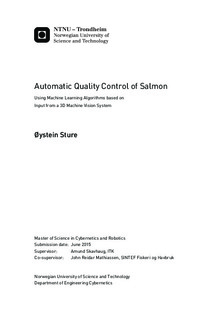Automatic Quality Control of Salmon - Using Machine Learning Algorithms based on Input from a 3D Machine Vision System
Master thesis
Permanent lenke
http://hdl.handle.net/11250/2352578Utgivelsesdato
2015Metadata
Vis full innførselSamlinger
Sammendrag
Quality control of Atlantic salmon is currently a task performed manually by human operators. To stay competitive in an increasingly global market, it becomes necessary to take advantage of technology to improve productivity and profitability. This is especially the case in countries with high salary levels. In this thesis, a complete machine vision system for 3D-imaging has been built and integrated for the purpose of quality control of Atlantic salmon. The system is build using off-the-shelf hardware, and has been integrated using no external proprietary tools. The software for the acquisition was implemented with real-time restrictions in mind. The end result is thus an affordable solution, which can be deployed in an industrial environment without major investments.
An experiment was then performed on Atlantic salmon of different quality classes. The obtained data was used to develop descriptors that capture enough information to separate out lower classes of Atlantic salmon based on its appearance. The thesis focuses on two primary causes of downgraded salmon; deformities and wounds. Deformities appear due to skeletal deformations and inflammation. Wounds appear due to cuts and scrapes that are infected by bacteria. Using geometric features and color information, two classifiers was developed to handle each of these cases. The classifiers have been found to reliably detect deformities and wounds in Atlantic salmon, and shows that 3D-imaging has great potential within the field of automatic quality control of fish.
